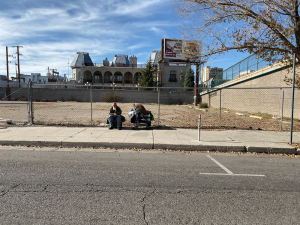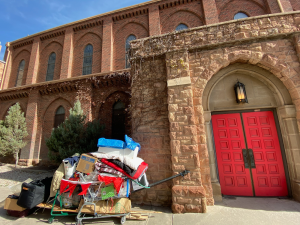According to a recent report, the homeless population is increasing in Albuquerque and several new initiatives hope to address the problem by building a new shelter, housing area, and better outreach on the streets.
In November, Albuquerque city residents voted to fund a $14 million centralized homeless shelter that will house 300 people and be open 24 hours a day, seven days a week. The location for the shelter is still under consideration.

Currently the city’s largest shelter, the Westside Emergency Housing Center, can house 400 people, or about 26 percent of the estimated homeless population in Albuquerque. The shelter is 20 minutes by car from downtown and offers transportation at different locations throughout the city.
For residents like Ava Rivera, more shelter space is needed, especially during the winter months.
“It’s really hard knowing that a storm is coming or it’s going to get cold and not having somewhere to go,” said Rivera, who has been struggling with homelessness for the past decade. “You can try to go to one of the shelters, but there’s no guarantee they’ll have room.”
While exact estimates of homelessness are hard to come by, the most recent count in January showed a 16% increase from the year before. The Point In Time Survey, which is conducted one night out of the year, is done by the New Mexico Coalition to End Homelessness. It collects information on the number of people living in shelters or outside. The count this year found 1,524 people to be homeless, compared to 1,318 people last year.
Another notable project hoping to reduce those numbers is Bernalillo County’s Tiny House Village, which will include 30 homes for people experiencing homelessness.
The project is designed to build a neighborhood for the homeless to get back on their feet. In 2016, it received more funding from the state of New Mexico And construction is set to begin next year.
The Tiny House Village will augment other county housing programs designed to support specific populations, such as men, women, families and individuals with substance abuse.
https://www.youtube.com/watch?v=LORNljzY5OA&feature=youtu.be
Other bright spots in dealing with the homeless issue include New Day Youth and Family Services, which has received a grant this year from the Housing and Urban Development Department (HUD) that will allow them to expand their street outreach targeting areas with high homeless populations.
“San Mateo and Central is kind of like the hub of sex trafficking in our city, so we’re going to take that knowledge and go out into the streets where the kids are, and try to have our staff members form a relationship with these young people,” Kelsey Martin, the development director at New Day said.
Homelessness among school age youth is also a sizable problem. Albuquerque Public Schools estimates between 3,000 and 4,000 students experience homelessness while enrolled.
“We have a youth drop-in center that opened this year in downtown Albuquerque and that’s kind of our base of operations for low barrier interactions for young people without a home,” Martin said.
Martin said young people can enter the space and receive food and toiletries, as well as information and resources on medical care and shelters.
Rivera, who has been experiencing homelessness for the past ten years, believes if she had access to services like those offered at New Day, she may have had a different experience.
“I became homeless because I started doing drugs and didn’t have any support from my family or anyone. It was all I really knew,” Rivera said.
“If I would have had extra help from someone, I would have lived a different life.”
– Ava Rivera
Meanwhile, existing programs in the City of Albuquerque are keeping busy helping people stay off the streets. For example, there are motel vouchers, distributed by St. Martin’s Hospitality Center. Also, there’s the Albuquerque Healthcare for the Homeless, which provides meals distributed at St. Martin’s Hospitality Center, plus free or discounted childcare, and additional transitional housing at smaller shelters across the city.

Hana Gosset, with the nonprofit New Mexico Coalition to End Homelessness, directs the Albuquerque Continuum of Care — a program to coordinate many local partners.
Gosset said The Coalition to End Homelessness works to provide resources and programs to people experiencing homelessness, as well as the members of the Coalition, which is comprised of numerous non profit organizations.
“The key for us is we really work to support our members,” Gosset said, “ and the community as a whole, to work towards ending homelessness.”
Kaylee Trainum is a reporter for the New Mexico News Port. She can be contacted on Twitter @kaylee_trainum or at nmnewsport@gmail.com